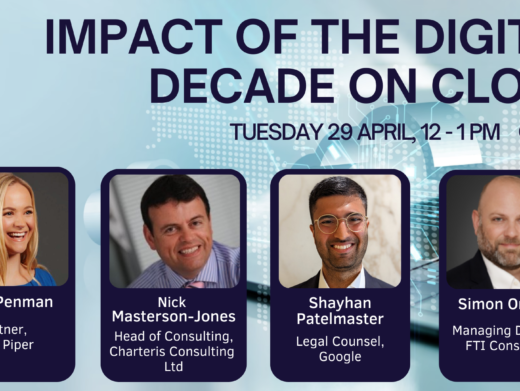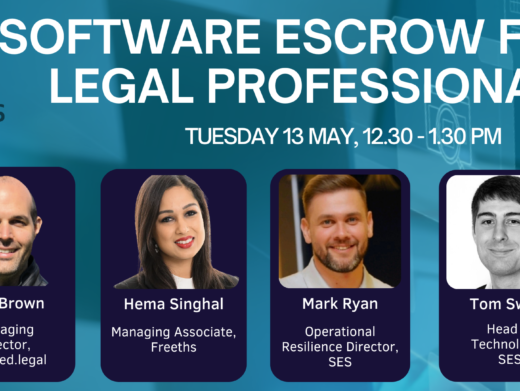At the Centre for Commercial Law Studies at Queen Mary University of London (QMUL), we have been teaching cloud computing law to postgraduate students for over a decade, both in-person at our London and Paris campuses, and online as part of our distance learning programme in Technology, Media, and Telecommunications Law. To take this to the next level, in 2021 we decided to produce a series of massive open online courses (or ‘MOOCs’). About a year and a half later, in October 2022, we launched a three course ‘specialisation’ in Cloud Computing Law on Coursera. In this article, we look back on the challenges we faced and the lessons we learned. We also look ahead to the future of online education and training.
In the beginning, there was COVID…
As lockdowns spread during the COVID-19 pandemic, university
campuses shut down and many international students were unable to travel. Facing
an uncertain future, QMUL decided to trial various forms of online education. The
new, digital strategy included a partnership with Coursera, a global platform
for online education.
At the Cloud Legal Project, we agreed to take part in the QMUL
pilot project by developing courses covering the legal implications of using
and providing cloud services. The courses would be based on our Cloud
Computing Law book, the second edition of which had recently been published
(OUP, 2021). The MOOC model would allow us to offer a very affordable learning option
for students who could not travel to London or Paris, whether due to COVID
measures, fees and other costs, or personal commitments to families and
careers. Reaching a broad audience is a priority for our research project,
which is funded through a series of charitable donations from Microsoft.
Overcoming obstacles
We started in high spirits, but soon ran into significant
challenges, mostly related to video content. Coursera courses typically feature
around an hour of video per teaching week, made up of 10-12 short videos of
around 5 minutes each. So, for the 10-week Specialisation we had planned, we
needed some 10 hours of slick, high-quality video per week, or about 100 short
videos in total. We had no direct experience of shooting or editing that kind
of material. To make matters worse, lockdowns meant we were all working from
home, so we couldn’t use a central, professional studio.
To solve this problem, we bought A/V equipment and simple
studio lights on Amazon and set up a DIY studio in a basement room at our
campus in Lincoln’s Inn Fields. Some presenters took turns recording short videos
there; while others recorded from home, setting up makeshift studios in living
rooms, bedrooms, a garage and even a garden shed! Presenters then uploaded their
files to the cloud, via Microsoft Teams and SharePoint.
High-quality video also needs clear audio. We bought a
couple of decent Tascam digital recorders but then had to work out how to
eliminate distracting background noises, such as from traffic or sirens. This
is not easy to achieve without soundproofing in central London, and some
presenters resorted to recording videos in the dead of night. However, after
much experimentation, we found ways to record well-lit footage with clear sound.
The next step was editing, which presented a separate
challenge. Cutting many hours of HD video and combining it with graphics required
not only appropriate hardware and software, but also a specialised skill set.
So, we worked with an external video-editing company that had been engaged
centrally by QMUL. Unfortunately, this brought its own challenges in terms of contracts,
costs, and coordination. To cut down on editing costs, we required all
presenters to record their footage in a single take.
The production company then uploaded draft versions of
edited videos to Vimeo for us to review. We left comments on Vimeo for the
editors, which worked a bit like comments in MS Word, but without the ability
to track changes. As a result, version control was a good deal more complicated
than for Word documents!
In contrast, preparing the other learning materials was much
more straightforward. Drafting explanatory notes, pulling together reading
lists, and setting questions for discussion forums and quizzes was more familiar
terrain. Once all the learning materials were ready, building the course on
Coursera was easy too. The platform has simple drag-and-drop tools. As a result,
building a course is about as simple as writing a blog on WordPress or listing
your home on Airbnb.
Launch and learn
In October 2022, we were finally ready to launch our three-course
specialisation on Coursera. Since then, we’ve had over 5,000 learners
sign up; we have issued nearly 1,200 course diplomas; and
learners have given the courses an average rating of 4.9 out of 5 stars.
Learners can audit the courses for free, or pay £40 per
month of study to obtain a diploma, which many share on LinkedIn and add to
their CVs. So far, the courses have raised tens of thousands of pounds in
revenues from individual and corporate subscribers. As part of our (complex) revenue-sharing
agreement with Coursera, a portion of these funds flows back into our research
budget.
We’ve learned that an online course differs from in-person
teaching in three important ways. First, to ensure scalability, we had to
design the three-course specialisation so that it requires no ongoing involvement
from the teaching team. For our traditional in-person and online distance
learning programmes, we deliver lectures and tutorials in physical or virtual
classrooms. That means we are in direct contact with students and can, for
example, answer their questions and guide them on their learning journey. In
contrast, our Coursera learners can only access the materials on the platform.
For the rest, they’re on their own.
To support Coursera learners, we set clear expectations and specified
measurable, clearly-defined learning objectives for each course. A learner’s progress
towards those objectives can then be tested through a series of automatically-graded,
multiple-choice quizzes. Learners obtain the knowledge they need to pass those
quizzes through the learning materials, such as videos and readings. But it’s
up to students to watch and read as much (or as little!) as they want; and to
decide for themselves when they’re ready to take each quiz.
Second, we get a different kind of feedback than we do from
face-to-face teaching. The Coursera platform tracks which videos learners
watch, how learners perform on quizzes, and whether, and if so when, they drop
out. This results in a wealth of data, which we can use to improve the courses.
For example, we can see which questions learners typically get wrong, and which
wrong answers they select most often. We can then use this to clarify any ambiguous
or overly-complex questions, or to tweak the quizzes to make it easier or
harder to achieve a pass grade.
We don’t get that kind of real-time, data-driven feedback
through in-person teaching or exam marking. However, we use the
Coursera materials and data analytics to improve our traditional teaching too.
For example, we can re-use the MOOC questions as practice quizzes for our LLM
students, or give them access to selected MOOC videos to reinforce points made
in class.
Third and finally, anyone with an interest in cloud
computing law can enroll in our Coursera specialisation. We can’t assume that learners
have a legal background, or an understanding of cloud computing. So, the challenge
was to design courses that anyone could follow. This meant explaining cloud
technologies and services in simple terms for lawyers, compliance professionals,
and regulators new to the world of cloud services. At the same time, for
computer scientists and business learners with little or no legal training, we
had to cover the basics of things like contract and data protection law. This
forced us to explain every technical concept and legal argument from first
principles. To borrow Einstein’s phrase, the challenge was to “make everything
as simple as possible, but not simpler”.
The future of online education?
A hands-off, asynchronous approach to teaching and learning is
scalable in a way that “live” teaching isn’t. Once an course is built on a
platform like Coursera, any number of students can take it. However, learners
don’t benefit from the same direct contact with faculty members they would get from
face-to-face classes and tutorials. As a result, live teaching (whether in
person or online) will remain our core offering, albeit as a premium service.
But we believe there’s plenty of room too for lower cost, scalable MOOCs
alongside our other programmes.
As technology improves, making a MOOC will become easier.
For example, Microsoft “Cameo” is a feature which lets you frame and embed video
from your webcam alongside the text and graphics on your PowerPoint slides. This
is a significant improvement over previous PowerPoint recording options. Had this
functionality existed in 2021, it would have significantly reduced our
video-editing needs. (Prezi has long offered a similar function, but its
controls are not particularly intuitive for users versed in PowerPoint. After
experimenting with Prezi, we decided against training our team to use it.) Meanwhile,
Software-as-a-Service (‘SaaS’) video solutions have made video capture and
editing tools more accessible; while Video Platform as a Service (‘VPaaS’)
services offer advanced content management and customisation options for more
sophisticated users.
In the longer term, AI is likely to reduce the costs of
making a MOOC even further. It could help generate scripts and graphics for
videos, automate video editing and, based on data analytics, suggest continuous
improvements to make courses more engaging. Indeed, what’s to stop someone
using AI to create new courses featuring deep-fakes of our faculty? This raises
plenty of interesting legal issues, which are beyond the scope of this article.
But they present fertile ground for future research and teaching, and perhaps,
someday, another Coursera Specialisation.
You can access the Cloud Computing Law Specialisation on
Coursera at https://bit.ly/cloud-law-course
or find out more about the Cloud Legal Project at https://www.qmul.ac.uk/cloudlegal/
Christopher Millard is Professor of Privacy and Information Law at the Centre for Commercial Law Studies, Queen Mary University of London, where he leads the Cloud Legal Project. He Is Senior Counsel to Bristows and is a Life Fellow and past-Chair of SCL.
Johan David Michels is a researcher with the Cloud Legal Project at the Centre for Commercial Law Studies, Queen Mary University of London (“QMUL”). He teaches cloud computing and e-commerce law at QMUL and the London School of Economics and is currently pursuing a PhD looking at property rights in digital assets.




